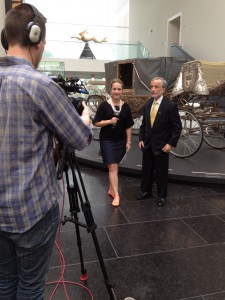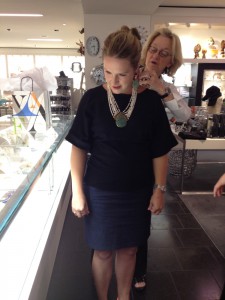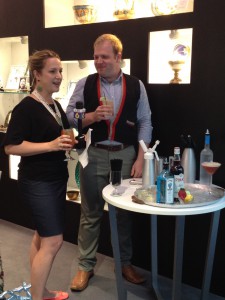 Maharaja: The Splendor of India’s Great Kings has made its television debut! WTVR/CBS 6 News’ executive producer, Jessica Noll, reported live from the VMFA yesterday morning for an exclusive look at one of the museum’s most opulent exhibitions yet. But as the rest of Richmond watched from home, I had the privilege of observing the broadcast from behind the camera.
Maharaja: The Splendor of India’s Great Kings has made its television debut! WTVR/CBS 6 News’ executive producer, Jessica Noll, reported live from the VMFA yesterday morning for an exclusive look at one of the museum’s most opulent exhibitions yet. But as the rest of Richmond watched from home, I had the privilege of observing the broadcast from behind the camera.
As an intern at the VMFA, even the most mundane work seems new and exciting, but this was exceedingly so. A lot of planning and collaboration went into the broadcast. Every detail was considered. Noll visited the VMFA the week before to view the Maharaja exhibition and discuss key objects and art with the museum’s chief communications officer, Suzanne Hall. Noll was introduced to the exhibition’s most interesting and important objects, like an ornate howdah (elephant throne) and a beautiful bridal ensemble. The Maharaja exhibition continues until August 19 and includes many other elaborate and fascinating pieces and works from India.
 During the broadcast, Noll reported from in front of a maharaja’s silver carriage, and VMFA director, Alex Nyerges, joined her for an interview. Nyerges shared general information about the exhibition and descriptions of a few of the key objects and art on display. Noll also spoke with Raven Lynch of the VMFA shop about featured products, including jewelry designed by one of the maharajas’ granddaughter, Jyotsna Chawla Singh. In fact, Noll wore a stunning necklace and earring set by Jyotsna throughout the broadcast. Finally, Michael Smith from Amuse Restaurant made and served a few Maharaja-inspired cocktails (yes, at 9:30 in the morning!).
During the broadcast, Noll reported from in front of a maharaja’s silver carriage, and VMFA director, Alex Nyerges, joined her for an interview. Nyerges shared general information about the exhibition and descriptions of a few of the key objects and art on display. Noll also spoke with Raven Lynch of the VMFA shop about featured products, including jewelry designed by one of the maharajas’ granddaughter, Jyotsna Chawla Singh. In fact, Noll wore a stunning necklace and earring set by Jyotsna throughout the broadcast. Finally, Michael Smith from Amuse Restaurant made and served a few Maharaja-inspired cocktails (yes, at 9:30 in the morning!).
Everything came together seamlessly. The broadcast was a success, and it was great to see all the contributing moving parts. I even got to do my part by complying a list of key objects within the exhibition for Noll’s research (see this information below). But that was just my experience – come enjoy Maharaja: The Splendor of India’s Great Kings for yourself!
Here are the links to the interviews:
About the exhibition
http://wtvr.com/2012/06/06/virginia-this-morning-vmfa-maharaja-the-splendors-of-indias-great-kings/
VMFA Shop and Amuse
http://wtvr.com/2012/06/06/virginia-this-morning-vmfa-maharaja-the-splendors-of-indias-great-kings/
 And here is the information I put together about key works in the exhibition:
And here is the information I put together about key works in the exhibition:
Maharaja’s Silver Carriage
· Fort Coach Factory Carriage, City of Bombay (Mumbai), 1915
· Made of iron, wood, silver, gilded silver, enamel, and silk
· Demonstrates British influence in India (a transition from the elephant)
· Beneath coat of arms reads a motto which translates, “Man’s Endeavors, God’s Grace,” which reflects the Hindu philosophy that all human actions are only rewarded by divine grace
Howdah (Elephant throne)
· Embellishment with royal symbols and execution in silver or gold demonstrates majesty of the king
· The sunburst design on the featured howdah may have been commissioned by a Rajput ruler who claimed descent from the sun
· VMFA has a howdah in its permanent collection
Poshakh (Bridal ensemble)
· Silk woven, embroidered with gold-wrapped thread, and adorned with metal sequins and beads
· Very heavy garment
· Bride was seated during the marriage ceremony and was thus able to wear the weighty garment with relative comfort
The Delhi Durbar of 1903
· Roderick McKenzie, possibly the city of Calcutta, 1907, oil on canvas
· Depicts procession of elephants celebrating the accession of Edward III to the British throne, and by extension, rule of India
· The King of England was not in attendance, but the viceroy and his wife as well as Prince Arthur, whom the king sent in his stead, lead the procession
· British durbars such as the Delhi Durbar of 1903 were selectively adopted from Indian tradition of royal procession and public ceremony
Pair of Occasional Tables
· Commissioned by Nawab Sadiq Muhammad Abbassi IV of Bahawalpur, one F. & C. Osler’s most important patrons, who ordered everything from cribs to beds in crystal
Turban Ornament
· Northern India, 1900-1925
· Made of diamonds, emeralds, rubies, enamel, and gold
· Commissioned by Sikh ruler, Maharaja Bhupinder Singh
· Traditional Indian jewelry
· Such unusually large pieces were worn on grand ceremonial occasions and were designed to complement the proportions of the Sikh turban
Necklace and Earrings
· Cartier, London, 1954
· Made of platinum, rubies, and diamonds
· Ordered by a fashionable maharani
· Royal families remained wealthy and important in Indian culture, despite independence in 1947
Throne of Maharaja Ranjit Singh
· Hafiz Muhammad Multani, city of Lahore, 1820
· Housed at the Victoria and Albert Museum in London
· Made of wood, resin, and gold
· Cusped base is composed of two tiers of lotus petals, which symbolize purity and creation
· The throne was taken to London after British victory over the Sikh kingdoms to represent British supremacy over the powerful Indian ruler
– Noelle Staib, Communications and Marketing Intern